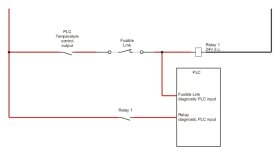ceilingwalker
Lifetime Supporting Member
Good day all. I have a dip-tank that contains acid and this tank is heated by a 12000watt heater. The way the control was wired was: when SP is less than PV, SLC500 Relay Output Module sends 120 VAC to a one-shot fuse (thermal fuse) and then returns to the control cabinet where it energizes a relay coil that pulls-in contacts, closing the 3-phase power, energizing the 3-phase heater. I had two objectives: 1. Remove the more dangerous 120 VAC in the operator’s path and use a lower 24 VDC circuit and 2. Create a more specific alarm for the one-shot fuse to aide maintenance techs while troubleshooting. I accomplished this by adding a DC-Sink input module and put 24VDC to the one-shot fuse and then connected the coil for the heater relay directly to the SLC500 Relay Output Module. Now this circuit works like this: 24 volts goes across the thermal one-shot fuse and lands on the DC-Sink module. As long as the processor sees a “1” in the bit box for that one-shot, and if the SP is less than the PV, the Output Module will energize the coil, pulling-in contacts and provide 3-phase power to heaters.
Here is my question: Can anyone think of a reason why would NOT be a good idea? I believe I have considered every possible safety precaution and have determined that the system will be just as safe however, I would like to hear what you experienced folks have to say. A second, third, fourth, etc…. pair of eyes on this will make me more comfortable with this change. Thank you
Here is my question: Can anyone think of a reason why would NOT be a good idea? I believe I have considered every possible safety precaution and have determined that the system will be just as safe however, I would like to hear what you experienced folks have to say. A second, third, fourth, etc…. pair of eyes on this will make me more comfortable with this change. Thank you






